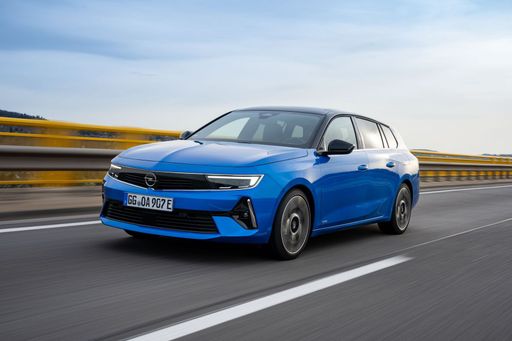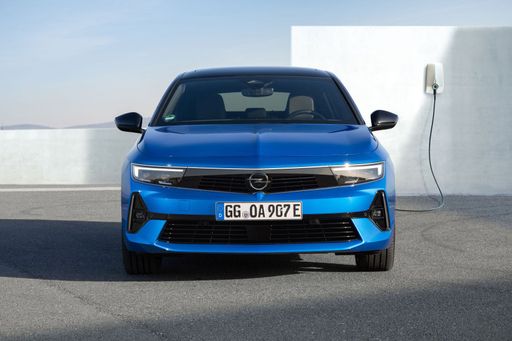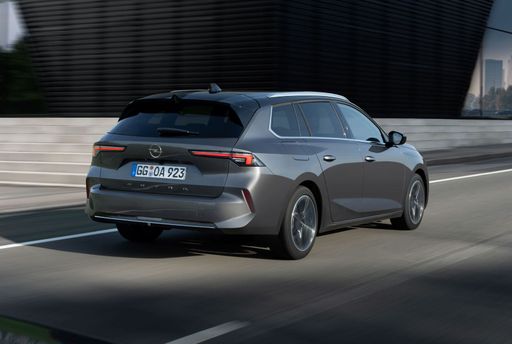Vauxhall Astra Sports Tourer VS Renault Trafic Bus – Specs, Efficiency & Price Comparison
Which model is the better choice – the Vauxhall Astra Sports Tourer or the Renault Trafic Bus? We compare performance (225 HP vs 170 HP), boot capacity (597 L vs ), efficiency (15.80 kWh1.30 L vs 6.80 L), and of course, the price (25200 £ vs 36000 £).
Find out now which car fits your needs better!
The Vauxhall Astra Sports Tourer (Estate) is powered by a Petrol MHEV, Petrol, Diesel, Plugin Hybrid or Electric engine and comes with a Automatic or Manuel transmission. In comparison, the Renault Trafic Bus (Bus) features a Diesel engine and a Manuel or Automatic gearbox.
When it comes to boot capacity, the Vauxhall Astra Sports Tourer offers 597 L, while the Renault Trafic Bus provides – depending on what matters most to you. If you’re looking for more power, you’ll need to decide whether the 225 HP of the Vauxhall Astra Sports Tourer or the 170 HP of the Renault Trafic Bus suits your needs better.
There are also differences in efficiency: 15.80 kWh1.30 L vs 6.80 L. In terms of price, the Vauxhall Astra Sports Tourer starts at 25200 £, while the Renault Trafic Bus is available from 36000 £.
Compare all the key specs now and find out which model fits your lifestyle best!
Vauxhall Astra Sports Tourer
The Opel Astra Sports Tourer is a stylish and practical estate car that offers a versatile blend of comfort and functionality. With its sleek design and spacious boot, it caters perfectly to families and those with an active lifestyle. The interior is thoughtfully designed, providing both driver and passengers with a comfortable and technologically enhanced experience.
details @ media.stellantis.com
@ media.stellantis.com
 @ media.stellantis.com
@ media.stellantis.com
 @ media.stellantis.com
@ media.stellantis.com
Renault Trafic Bus
The Renault Trafic Bus is a versatile and spacious option for those needing to transport multiple passengers comfortably. With its modern design and practical features, it is well-suited for both business and leisure purposes. Its efficient engine and smooth handling make it a reliable choice for long journeys.
details

|
|
|
|
|
Costs and Consumption |
|
|---|---|
|
Price
25200 - 41800 £
|
Price
36000 - 51900 £
|
|
Consumption L/100km
1.3 - 5.9 L
|
Consumption L/100km
6.8 - 7.2 L
|
|
Consumption kWh/100km
15.80 kWh
|
Consumption kWh/100km
-
|
|
Electric Range
63 - 413 km
|
Electric Range
-
|
|
Battery Capacity
11.3 - 51 kWh
|
Battery Capacity
-
|
|
co2
0 - 134 g/km
|
co2
178 - 190 g/km
|
|
Fuel tank capacity
42 - 52 L
|
Fuel tank capacity
80 L
|
Dimensions and Body |
|
|---|---|
|
Body Type
Estate
|
Body Type
Bus
|
|
Seats
5
|
Seats
8
|
|
Doors
5
|
Doors
4
|
|
Curb weight
1376 - 1760 kg
|
Curb weight
2041 - 2340 kg
|
|
Trunk capacity
516 - 597 L
|
Trunk capacity
-
|
|
Length
4642 mm
|
Length
5080 - 5480 mm
|
|
Width
1860 mm
|
Width
1956 mm
|
|
Height
1443 - 1481 mm
|
Height
1973 - 1974 mm
|
|
Payload
424 - 497 kg
|
Payload
730 - 1010 kg
|
Engine and Performance |
|
|---|---|
|
Engine Type
Petrol MHEV, Petrol, Diesel, Plugin Hybrid, Electric
|
Engine Type
Diesel
|
|
Transmission
Automatic, Manuel
|
Transmission
Manuel, Automatic
|
|
Transmission Detail
Dual-Clutch Automatic, Manual Gearbox, Automatic Gearbox, Reduction Gearbox
|
Transmission Detail
Manual Gearbox, Dual-Clutch Automatic
|
|
Drive Type
Front-Wheel Drive
|
Drive Type
Front-Wheel Drive
|
|
Power HP
110 - 225 HP
|
Power HP
110 - 170 HP
|
|
Acceleration 0-100km/h
7.6 - 11 s
|
Acceleration 0-100km/h
10.6 - 16.5 s
|
|
Max Speed
170 - 235 km/h
|
Max Speed
161 - 186 km/h
|
|
Torque
205 - 360 Nm
|
Torque
300 - 380 Nm
|
|
Number of Cylinders
3 - 4
|
Number of Cylinders
4
|
|
Power kW
81 - 165 kW
|
Power kW
81 - 125 kW
|
|
Engine capacity
1199 - 1598 cm3
|
Engine capacity
1997 cm3
|
General |
|
|---|---|
|
Model Year
2023 - 2024
|
Model Year
2023
|
|
CO2 Efficiency Class
C, D, B, A
|
CO2 Efficiency Class
G
|
|
Brand
Vauxhall
|
Brand
Renault
|
Vauxhall Astra Sports Tourer
Discover the Opel Astra Sports Tourer: Innovation Meets Performance
The Opel Astra Sports Tourer has long been a staple in the world of estate cars, providing a perfect blend of versatility, comfort, and performance. The latest iterations of this model have raised the bar even higher with cutting-edge technology and an array of engine options that cater to various driving preferences. In this article, we explore the technical details and innovations that make the Opel Astra Sports Tourer a standout choice in its category.
Engine Choices: A Spectrum of Efficiency and Power
The Opel Astra Sports Tourer offers a selection of powertrains that ensure there's something for everyone. From super-efficient hybrid models to robust petrol and diesel options, drivers can choose based on their needs. The plug-in hybrid variants are particularly noteworthy, offering an impressive electric range of up to 65 km and fuel consumption as low as 1.3 L/100 km, showcasing Opel's commitment to sustainability.
Technical Highlights: Advanced Engineering
Under the bonnet, the Astra Sports Tourer features a range of three to four-cylinder engines, with capacities ranging from 1199 to 1598 cm³. The power output varies between 110 PS (81 kW) to a vigorous 225 PS (165 kW), ensuring that whether you need a car for city commutes or long-distance drives, the Astra Sports Tourer has an option suited for you.
Acceleration times from 0-100 km/h range from 7.6 to 11 seconds, paired with maximum speeds between 170 to 235 km/h, making this estate not only efficient but also quick on its wheels when needed.
Innovative Design: Space Meets Style
With a length of 4642 mm and a width of 1860 mm, the Astra Sports Tourer offers generous interior space without compromising on style. Its boot capacity ranges from 516 to 597 litres, ensuring there’s plenty of room for luggage on long trips. Additionally, innovative design elements make this vehicle stand out, particularly in its GS and Ultimate lines, which offer premium features and finishes.
State-of-the-Art Technology: The Modern Drive
The Astra Sports Tourer is packed with technology to enhance the driving experience. This includes an advanced infotainment system and a suite of driver assistance features. These modern touches ensure that every journey is as comfortable and safe as possible, demonstrating Opel’s focus on blending practicality with cutting-edge innovation.
Conclusion: The Future of Estate Vehicles
With a perfect balance of efficiency, performance, and innovative design, the Opel Astra Sports Tourer redefines what drivers can expect from an estate vehicle. Whether prioritising low running costs or a sporty drive, this model delivers across various parameters. As Opel continues to innovate and respond to the evolving needs of motorists, the Astra Sports Tourer stands as a testament to their engineering prowess and visionary approach to automotive design.
Renault Trafic Bus
A Glimpse into the Renault Trafic Bus: An Icon of Versatility and Innovation
Amongst the plethora of vans designed for both business and leisure, the Renault Trafic Bus stands out as an exemplar of functionality, innovation, and style. Let's delve into what makes the Renault Trafic Bus a popular choice in the UK and across Europe, particularly focusing on its technical specifications and state-of-the-art features.
Performance Dynamics: Power Under the Hood
The Renault Trafic Bus, a staple in Renault's fleet, is driven by a robust diesel engine configuration with power outputs ranging from 110 PS to a formidable 170 PS. The diesel engines combine efficiency and power, offering torque figures between 300 to 380 Nm, ensuring smooth power delivery and capable load hauling.
Drivers can choose between manual and automatic transmissions, both designed to complement the Trafic's front-wheel-drive system. This flexibility ensures that drivers experience enhanced driving comfort whether they are navigating urban roads or cruising on the motorway.
Efficiency Meets Economy
The Trafic Bus showcases impressive fuel economy with consumption figures ranging from 6.8 to 7.2 litres per 100 kilometres. This efficiency is crucial for businesses aiming to minimise operational costs and for families seeking budget-friendly travel options.
With a generous fuel tank capacity of 80 litres, the Renault Trafic Bus is built to cover long distances with fewer fuel stops, making it an ideal choice for long haul journeys.
Technological Innovations and Comfort
The Trafic Bus isn't just about robust performance. Renault has integrated a suite of technological innovations designed to enhance driver and passenger comfort. Its cabins are equipped with the latest infotainment systems and safety technologies, providing an optimal blend of comfort and convenience.
The various trims, such as Life, Start, Spaceclass, and their respective EDC variants, cater to different needs and preferences, ensuring that customers can find the perfect configuration for their requirements.
Design and Dimensions: Space for Every Purpose
Space and versatility are at the heart of the Trafic Bus design. With its dimensions ranging from a length of 5080 to 5480 mm, and a width of 1956 mm, this vehicle offers ample room for passengers and cargo alike. The height stands between 1973 and 1974 mm, ensuring that even taller individuals can travel comfortably.
With seating for up to eight people and a payload capacity between 730 to 1010 kg, the Trafic Bus can transform seamlessly between a people-mover and a goods carrier.
Environmental Considerations
Renault has engineered the Trafic Bus with environmental responsibility in mind. The CO2 emissions range from 178 to 190 g/km, which, while modest for its class, aligns with the efficiency and performance goals set for this versatile vehicle. The CO2 efficiency class is rated as 'G', offering transparency in its environmental impact profile.
Conclusion: A Leader in Its Class
The Renault Trafic Bus continues to lead its segment through a blend of power, efficiency, and technological advancements. Whether it's for commercial transport or family adventures, the Trafic offers a reliable and adaptable solution, setting a high standard for multi-purpose vehicles.
For those seeking a distinguished blend of utility and comfort, the Renault Trafic Bus emerges as an exceptional choice, promising performance and innovation on every journey.
The prices and data displayed are estimates based on German list prices and may vary by country. This information is not legally binding.
